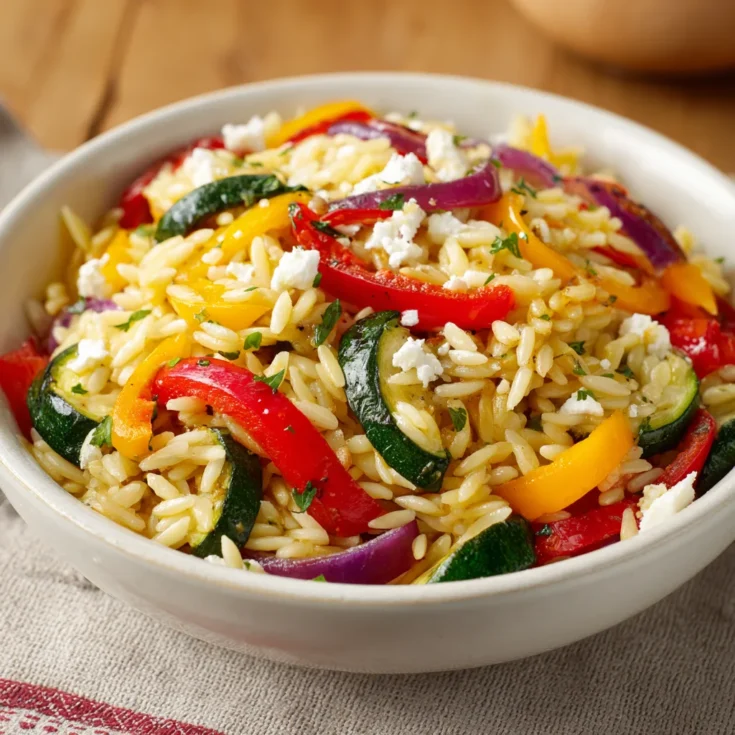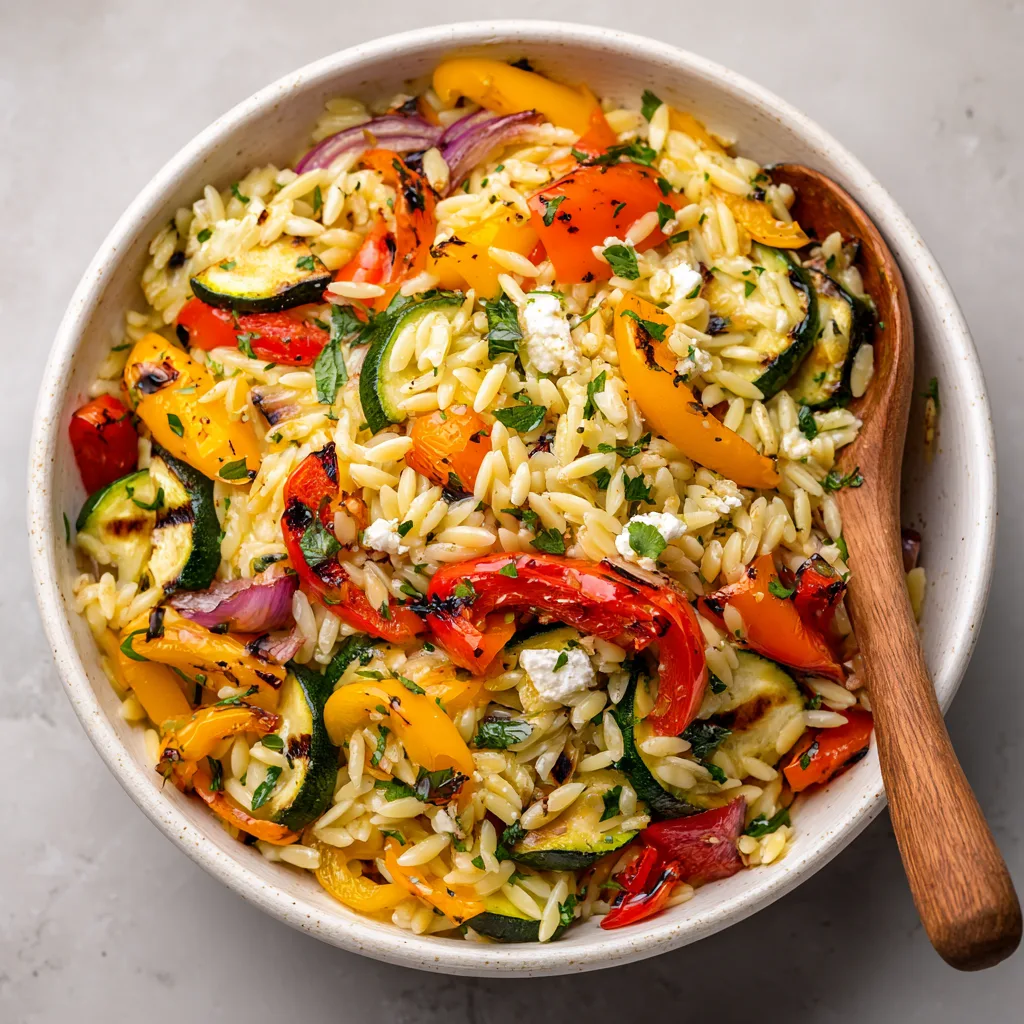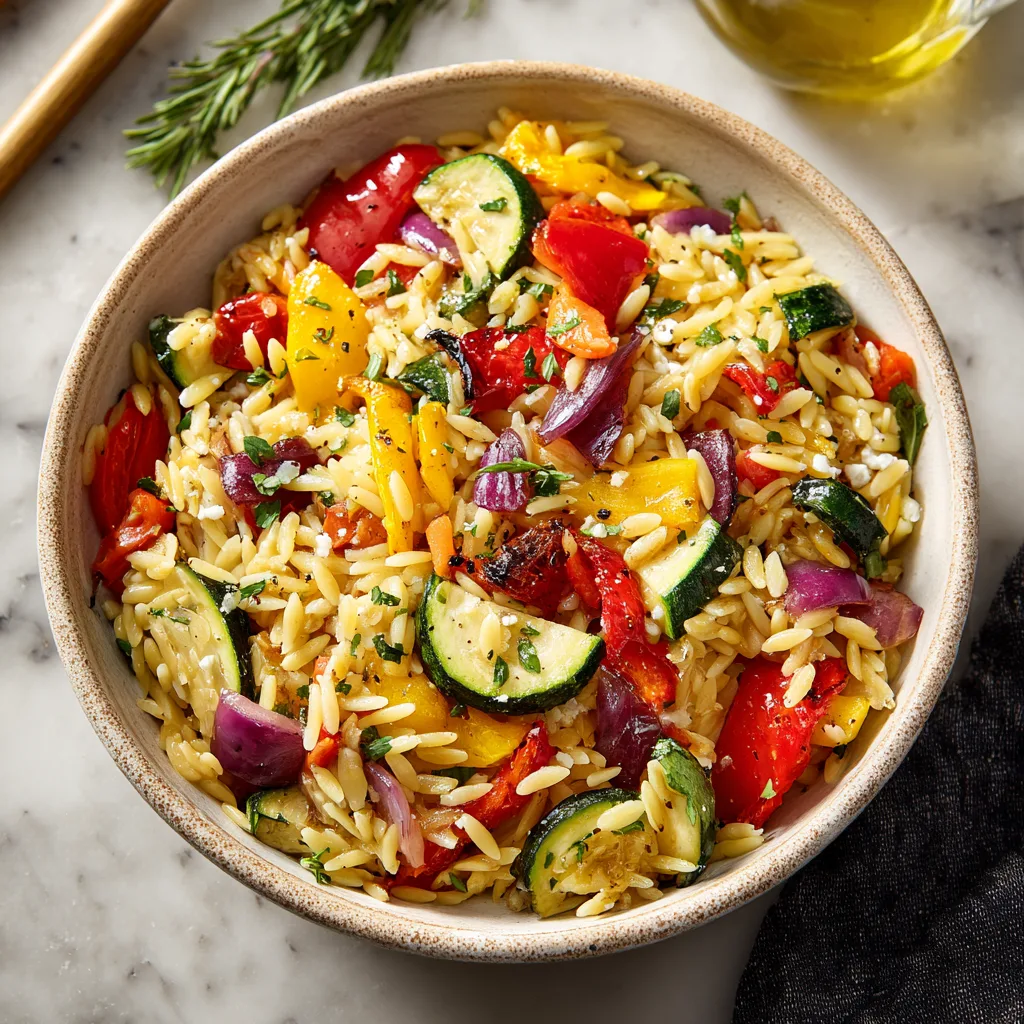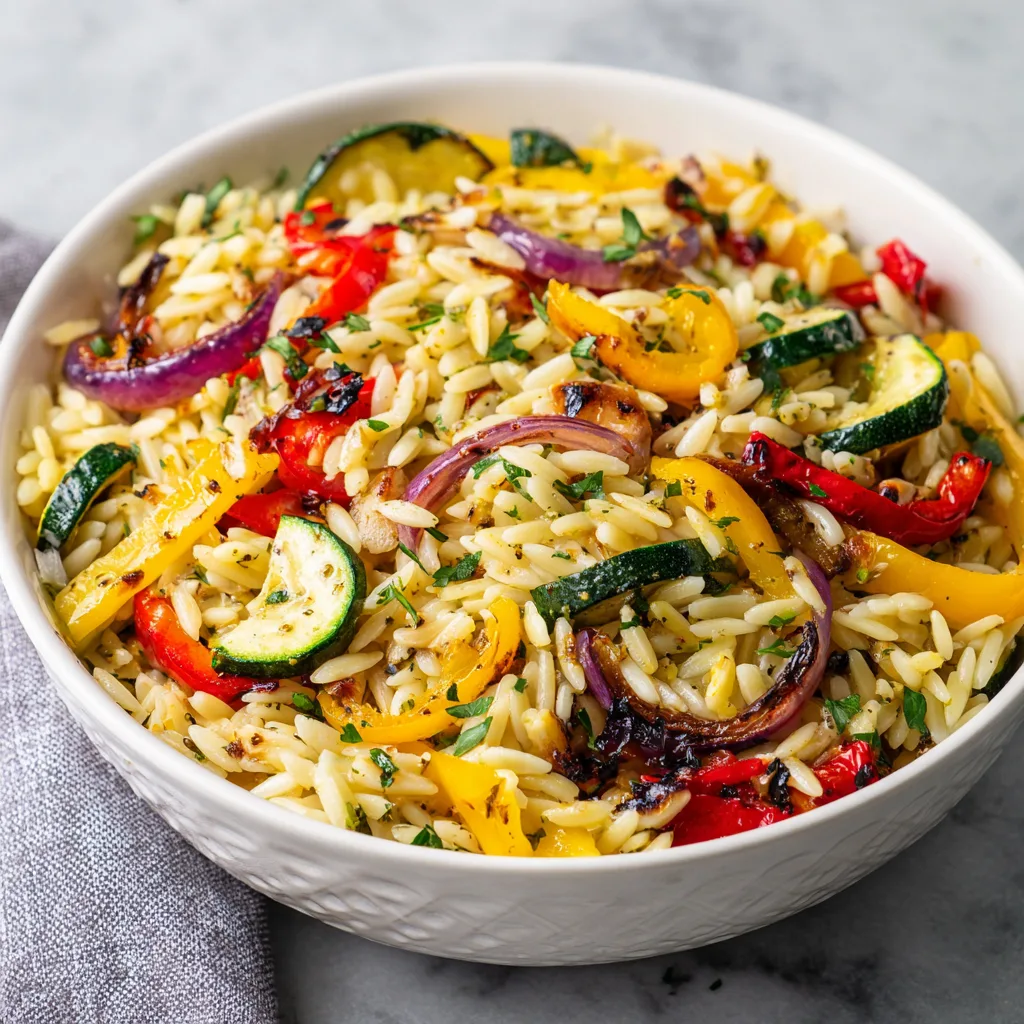What is Orzo Salad?
Orzo salad features small, rice-shaped pasta called orzo, which cooks quickly and offers a tender yet slightly chewy texture. Its subtle flavor makes it an excellent base, absorbing dressings and complementing other ingredients beautifully. This pasta’s versatility allows it to pair well with a variety of vegetables, herbs, and proteins, making it a popular choice for light, refreshing salads. Orzo salad can serve as a side dish, main course, or picnic favorite, adapting easily to different cuisines and seasons.
The Appeal of Roasted Summer Vegetables
Summer vegetables bring vibrant colors, sweet flavors, and a rich, natural juiciness that roasting intensifies. Vegetables like zucchini, bell peppers, cherry tomatoes, and corn burst with freshness during the summer months, making them ideal candidates for roasting. This cooking method caramelizes their natural sugars, deepening their taste and adding smoky undertones. Roasted summer vegetables also add a pleasing variety of textures, from tender to slightly crisp, making every bite exciting and satisfying.
Why Combine Orzo with Roasted Vegetables?
Pairing orzo with roasted vegetables creates a harmonious blend of textures and flavors. The soft, fluffy orzo contrasts nicely with the slightly charred, caramelized veggies. Roasting unlocks the sweetness and complexity of vegetables, which enhances the overall flavor profile of the salad. The combination results in a dish that is both hearty and light, offering freshness with a depth of taste that keeps each mouthful interesting and balanced.
Ideal Occasions for Serving This Salad
This bright and zesty orzo salad suits a wide range of occasions. It shines at summer picnics, potlucks, and outdoor barbecues where light, fresh dishes are welcome. It also makes an excellent lunch or dinner side, complementing grilled proteins or plant-based meals. Its portability and ability to be served warm, at room temperature, or chilled make it a versatile choice for busy weekdays or casual gatherings with friends and family.
Selecting the Right Ingredients
Choosing Quality Orzo for Salad Success
Start with high-quality orzo pasta to ensure the best texture and flavor. Look for orzo made from durum wheat semolina, which offers a firm bite and holds up well when mixed with other ingredients. If you prefer gluten-free options, rice or corn-based orzo alternatives work well. Avoid overcooked orzo, as mushy pasta can dilute the salad’s freshness. Properly cooked orzo should be tender but slightly firm to the bite, providing a pleasant chewiness that balances the salad.
Seasonal Summer Vegetables to Elevate Flavor
Summer vegetables are the heart of this salad. Choose fresh zucchini, bell peppers (red, yellow, or orange), cherry tomatoes, and corn for vibrant colors and flavors. These vegetables deliver natural sweetness and juicy textures that roasting enhances. You can also include eggplant, summer squash, or green beans to add variety. Selecting ripe, in-season vegetables ensures peak flavor and nutrition. Buying from local markets or farmers helps guarantee freshness and supports seasonal eating.
Fresh Herbs and Aromatics That Brighten Every Bite
Fresh herbs like basil, mint, and parsley add a burst of freshness and complexity to the salad. Basil imparts a sweet, slightly peppery note that complements roasted vegetables. Mint offers a cool, refreshing contrast, while parsley brings mild earthiness and vibrant color. Aromatics such as minced garlic or shallots enhance the flavor depth without overpowering the dish. Using fresh herbs rather than dried elevates the salad’s brightness and makes every bite lively.
Dressings and Seasonings for Perfect Balance
The dressing ties all the ingredients together. A zesty lemon vinaigrette works beautifully, offering bright acidity that cuts through the roasted vegetables’ sweetness. Alternatively, a Dijon mustard-based dressing adds a subtle tang and creamy texture. Balsamic vinegar-based dressings bring a rich, slightly sweet flavor that enhances the natural caramelization of roasted veggies. Use good-quality olive oil as a base and season with salt and freshly ground black pepper to bring out the flavors fully.
Preparation Techniques
Roasting Vegetables to Perfection
Preheat your oven to 425°F (220°C) for optimal roasting. Cut vegetables into uniform pieces to ensure even cooking. Toss them in olive oil, salt, and pepper before spreading them out on a baking sheet in a single layer. Roast the vegetables for 20 to 25 minutes, turning halfway through to achieve even caramelization. Roasting concentrates their sweetness and adds a slight char, bringing out a deeper, richer flavor that makes the salad irresistible.
Cooking Orzo for Ideal Texture
Bring a large pot of salted water to a boil. Add orzo and cook according to package instructions, usually 8 to 10 minutes, until al dente. Stir occasionally to prevent sticking. Drain the orzo and rinse briefly under cold water to stop the cooking process and cool the pasta. This step also removes excess starch, keeping the salad light and preventing clumping. Properly cooked orzo provides a tender base with a slight bite that complements the roasted vegetables perfectly.
Assembling the Salad for Harmonious Flavor
In a large mixing bowl, combine the cooled orzo and roasted vegetables. Add chopped fresh herbs and any aromatics you’ve prepared. Drizzle the dressing over the salad and toss gently to coat all ingredients evenly. Taste and adjust seasoning with additional salt, pepper, or lemon juice if needed. For extra texture and flavor, sprinkle toasted pine nuts or crumbled feta cheese on top before serving. This thoughtful assembly creates a balanced salad bursting with color, flavor, and delightful textures.
Understanding Flavor Profiles in Orzo Salad
Balancing Sweetness and Acidity for a Perfect Taste
Roasted summer vegetables naturally develop a sweet, caramelized flavor that adds richness to the salad. This sweetness creates a wonderful contrast when paired with bright, acidic dressings like lemon vinaigrette or red wine vinegar. The acidity cuts through the roasted veggies’ richness, balancing the dish and preventing it from feeling heavy. This interplay between sweet and tart creates a refreshing and harmonious flavor profile that excites the palate with every bite.
Incorporating Umami to Deepen Flavor Complexity
Adding ingredients rich in umami elevates the salad’s taste. Crumbled feta cheese introduces a salty creaminess that pairs well with roasted vegetables. Kalamata olives offer briny, slightly bitter notes that add depth and dimension. Sun-dried tomatoes can also boost the savory profile. These umami elements enrich the overall flavor, making the salad more satisfying and complex without overwhelming the fresh ingredients.
Enhancing the Salad with Fresh Herbs
Fresh herbs brighten and elevate the salad’s flavor. Basil contributes a sweet and peppery note, while parsley adds freshness and mild earthiness. Mint introduces a cool, invigorating taste that complements both sweet and savory ingredients. Herbs provide a burst of color and aroma that makes the salad feel vibrant and lively. They tie the dish together by adding layers of flavor that highlight the freshness of the roasted vegetables and orzo.
Creative Variations to Customize Your Orzo Salad
Protein Additions to Boost Nutrition and Flavor
Incorporate grilled chicken or shrimp for a hearty, protein-rich version that transforms the salad into a complete meal. These options add savory flavor and satisfying texture. For plant-based protein, chickpeas work wonderfully. They offer a nutty flavor and extra fiber while keeping the dish light. Adding protein not only enhances taste but also makes the salad a more filling, balanced option for lunches or dinners.
Vegan and Gluten-Free Adaptations
To make the salad vegan, simply omit cheese and use a plant-based dressing without honey or dairy ingredients. Gluten-free orzo made from rice, corn, or quinoa provides a suitable substitute without sacrificing texture or flavor. Quinoa itself is an excellent gluten-free alternative, adding extra protein and a slightly nutty taste. These modifications keep the salad accessible to various dietary preferences while maintaining its deliciousness.
International Twists for Exciting Flavor Profiles
Introduce Mediterranean flavors with ingredients like artichoke hearts, sun-dried tomatoes, and capers for a tangy, bold twist. Middle Eastern-inspired versions can include za’atar seasoning, roasted eggplant, and fresh mint to add complexity and warmth. Adding spices like cumin or smoked paprika introduces an earthy, smoky note that complements the sweetness of roasted vegetables. These global influences add variety and excitement, making the salad adaptable to many taste preferences.
Serving and Pairing Suggestions for Orzo Salad with Roasted Summer Vegetables
Temperature Considerations for Serving Orzo Salad
This versatile salad can be served warm, at room temperature, or chilled, depending on your preference and the occasion. Serving it warm right after roasting vegetables brings out cozy, rich flavors and makes the dish feel hearty. At room temperature, the salad allows the flavors to meld, creating a balanced and approachable taste. Chilling the salad enhances its refreshing qualities, making it ideal for hot days or picnic settings. Regardless of temperature, the salad maintains its bright and zesty character, adapting well to your serving style.
Presentation Tips to Elevate Visual Appeal
Presentation plays a vital role in making this salad irresistible. Use a large, shallow bowl or platter to showcase the vibrant colors of the roasted vegetables and fresh herbs. Garnish with extra chopped basil or parsley to add pops of green that contrast beautifully with the reds and yellows. Toasted pine nuts or crumbled feta cheese sprinkled on top add texture and visual interest. For a finishing touch, drizzle a little olive oil or an additional splash of lemon juice to make the ingredients glisten. These small details enhance both the look and flavor of your salad.
Pairing Orzo Salad with Complementary Dishes
Complementary Proteins That Elevate the Meal
This salad pairs exceptionally well with a variety of proteins. Grilled chicken breasts or thighs complement the fresh, zesty flavors with smoky, savory notes. For seafood lovers, grilled shrimp or baked fish offer a light, healthy balance. Plant-based proteins such as marinated tofu or roasted chickpeas blend well, adding substance without overpowering the dish. These options turn the salad into a complete, satisfying meal suitable for lunch or dinner.
Beverage Pairings to Refresh and Complement
Pair this bright orzo salad with refreshing beverages that enhance its fresh flavors. Iced herbal teas, such as mint or chamomile, complement the herbal notes in the salad while providing a cooling effect. Sparkling water infused with citrus slices or cucumber offers a crisp, clean contrast that balances the salad’s acidity. These non-alcoholic drinks refresh the palate and complete the dining experience without overshadowing the salad’s vibrant taste.
FAQs About Bright and Zesty Orzo Salad with Roasted Summer Vegetables
Can I Use Other Types of Pasta Instead of Orzo?
Yes, several pasta types work well as orzo substitutes. Small pasta shapes like couscous, acini di pepe, or tiny shells offer similar textures and allow flavors to blend beautifully. If you prefer larger pasta, consider small elbow macaroni or mini penne, but keep in mind that the texture and presentation will slightly change. For gluten-free options, quinoa or rice pasta are excellent alternatives that maintain a light, fluffy consistency suitable for salads.
How Long Can I Store the Salad?
Store the orzo salad in an airtight container in the refrigerator to keep it fresh. It will remain good for up to 3 to 4 days. To prevent sogginess, keep the dressing separate if you plan to store it for longer than a day. Toss the salad with the dressing just before serving to maintain crisp textures and vibrant flavors. Always check for signs of spoilage like off smells or discoloration before consuming leftovers.
Can I Prepare the Salad in Advance?
Absolutely. Preparing this salad ahead of time makes it convenient for busy days or gatherings. Roast the vegetables and cook the orzo in advance, then store them separately or combined without dressing. Add fresh herbs and toss with the dressing just before serving to preserve freshness and texture. Preparing the salad a few hours to a day in advance allows flavors to meld beautifully, enhancing the overall taste without compromising quality.
What Are Some Topping Ideas to Customize the Salad?
Customizing your orzo salad with toppings adds texture and extra flavor. Toasted pine nuts or slivered almonds provide a satisfying crunch. Seeds like pumpkin or sunflower seeds add nuttiness and nutritional benefits. Crumbled cheeses such as feta or goat cheese introduce creamy, tangy elements that complement roasted vegetables. For extra freshness, consider adding sliced olives, sun-dried tomatoes, or chopped scallions. These toppings let you personalize the salad to suit your taste preferences and occasion.
Bright and Zesty Orzo Salad with Roasted Summer Vegetables

This vibrant Mediterranean-inspired salad combines tender, al dente orzo pasta with sweet, caramelized roasted summer vegetables. Fresh herbs and a tangy lemon vinaigrette brighten each bite, creating a refreshing yet hearty dish perfect as a side or light meal.
Ingredients
- 1 cup orzo pasta
- 1 zucchini, diced
- 1 red bell pepper, diced
- 1 yellow bell pepper, diced
- 1 cup cherry tomatoes, halved
- 1 ear of corn, kernels removed
- 2 tablespoons olive oil
- Salt and pepper, to taste
- 1/4 cup fresh basil, chopped
- 1/4 cup fresh parsley, chopped
- 1/4 cup crumbled feta cheese (optional)
- 1/4 cup toasted pine nuts (optional)
- Dressing:
- 3 tablespoons olive oil
- 1 tablespoon red wine vinegar
- Juice of 1 lemon
- 1 teaspoon Dijon mustard
- Salt and pepper, to taste
Instructions
Notes




